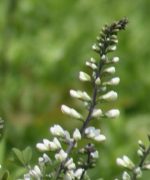 White false indigo is a herbaceous perennial and a member of the legume family, Fabaceae, that also includes peas, mimosa, and lupine.it is native to North American where is grows in dry meadows and forest edges. Plants have a deep tap root and stout sparsely branched stems that grow three to sex feet tall. The greyish/blue green leaves are obovate to oblanceolate, hairless, and compound with three leaflets that are two inches long and pointed at both ends. Racemes up to two feet long carry 1″ flowers that are white sometimes tinged with purple. The flowers appear from late spring to mid-summer and give way to green seedpods that are two inches long and turn black with maturity. The generic name, Baptisia, comes from the Greek word bapto meaning to dip or dye and refers to the flower extract once used as a substitute for indigo. The specific epithet, leucantha, comes from the Greek words leukos meaning white, and anthos, meaning flower, and refers to the color of the flowers.Type: Herbaceous perennial
White false indigo is a herbaceous perennial and a member of the legume family, Fabaceae, that also includes peas, mimosa, and lupine.it is native to North American where is grows in dry meadows and forest edges. Plants have a deep tap root and stout sparsely branched stems that grow three to sex feet tall. The greyish/blue green leaves are obovate to oblanceolate, hairless, and compound with three leaflets that are two inches long and pointed at both ends. Racemes up to two feet long carry 1″ flowers that are white sometimes tinged with purple. The flowers appear from late spring to mid-summer and give way to green seedpods that are two inches long and turn black with maturity. The generic name, Baptisia, comes from the Greek word bapto meaning to dip or dye and refers to the flower extract once used as a substitute for indigo. The specific epithet, leucantha, comes from the Greek words leukos meaning white, and anthos, meaning flower, and refers to the color of the flowers.Type: Herbaceous perennial
Bloom:Racemes up to two feet long of 1″ white flowers sometimes tinged with purple; in late spring to mid-summer
Size: 3-6′ H x 2′ W
Light: Full sun (tolerates some shade but may bloom poorly)
Soil: Average, medium moist, well-drained; tolerates lean soil but not alkaline soil.
Hardiness: Zones 3-10
Care: Cut back when seed pods form.
Pests and Diseases: None of significance
Propagation: Seed; does not transplant well.
Companion Plants:Sunflower (Helianthus spp), goldenrod (Solidago spp), asters, grasses such as Sporobolus heterolepis and Andropogon